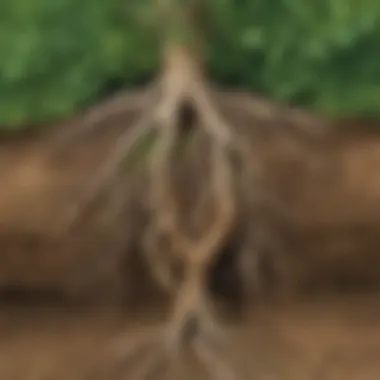Harnessing the Power of Plants: An In-Depth Look at Erosion Prevention


Science Fun Facts
Plants have evolved intricate root systems that anchor them firmly into the soil, contributing to preventing erosion in natural landscapes. Some plants even have specialized root structures that help bind soil particles together, providing essential stability in erosion-prone areas.
Discover the Wonders of Science
Understanding how plants help prevent erosion involves diving into the world of soil science. By exploring concepts like water runoff and soil compaction, young science enthusiasts can grasp the vital role vegetation plays in maintaining healthy ecosystems. Interactive tools and real-life examples can further engage them in this fascinating scientific journey.
Science Experiment Showcase
One fun experiment to showcase the erosion-preventing properties of plants is creating a mini terrarium. By planting grass or small shrubs in a container filled with soil, children can observe firsthand how roots hold the soil in place, preventing erosion. Providing step-by-step instructions, a materials list, and safety tips ensures a safe and educational experiment for young learners.
Introduction
In this article, we embark on a journey to unravel the critical role that plants hold in the intricate web of ecosystems. By delving into how plants aid in preventing erosion, we open young minds to the fascinating realm of environmental science. Understanding the mechanisms through which plants contribute to soil stability and erosion control is fundamental for fostering a deeper appreciation of nature's inherent mechanisms.
The Significance of Plants in Ecosystems
Plants emerge as pivotal actors in maintaining the delicate balance within ecosystems. Their key role in upholding this equilibrium lies in their unparalleled ability to regulate nutrient cycles and oxygen levels, thereby supporting diverse life forms. The unique characteristic of plants lies in their capability to act as primary producers, fueling entire food chains and enabling the sustenance of various species. A closer examination of the impact of plant cover on soil protection reveals the profound benefits that plants bestow on the soil. Through their intricate root systems, they not only anchor the soil, reducing erosion risks, but also enhance soil fertility through the decomposition of organic matter.
Understanding Erosion
Erosion stands as a force that shapes landscapes, spurred by various factors and processes. Delving into the causes and effects of erosion uncovers a complex interplay of natural elements, human activities, and environmental dynamics. Each type of erosion process, whether due to water, wind, or ice, uniquely influences the topography, altering terrain and impacting ecosystems differently. Recognizing the different types of erosion processes sheds light on the diverse mechanisms through which landscapes evolve, underlining the need for sustainable land management practices to mitigate erosion risks.


The Role of Plants in Erosion Prevention
In this insightful article on how plants help prevent erosion, we delve into the critical role that plants play in maintaining soil stability and averting erosion. By unraveling the intricate relationship between vegetation and erosion control, young science enthusiasts can grasp the significance of plants in preserving our delicate ecosystems. Through a detailed exploration of key elements such as root systems, vegetation cover, and nutrient recycling, readers are invited to uncover the underlying mechanisms that make plants effective guardians against erosion.
Root Systems and Soil Stability
Impact of root systems on soil erosion prevention
Root systems serve as a foundational element in the battle against erosion. The intricate network of roots not only helps in binding the soil particles together but also acts as a barrier against the erosive forces of wind and water. This inherent stability offered by root systems plays a crucial role in preventing soil erosion, making them indispensable in erosion control strategies. Despite the challenges posed by varying soil types and climatic conditions, the resilience of root systems remains a steadfast asset in safeguarding against erosion.
Types of plants with effective root structures
Certain plant species exhibit remarkable root structures that enhance their efficacy in erosion prevention. These plants, with their robust and penetrating root systems, anchor firmly into the soil, creating a stronghold against erosion. Their ability to thrive in diverse environments adds to the versatility of using these plants for erosion control. While some species may require specific soil conditions to flourish, their unparalleled ability to fortify the soil against erosion underscores their importance in sustainable land management practices.
Vegetation Cover and Slope Protection
Benefits of vegetation in reducing surface runoff
Vegetation plays a pivotal role in reducing surface runoff by absorbing rainfall and preventing it from cascading over the soil surface. This essential function not only mitigates soil erosion but also contributes to groundwater recharge and sustains ecosystem balance. The protective shield offered by vegetation cover serves as a natural barrier against erosive forces, highlighting the significance of incorporating diverse plant species for comprehensive erosion control measures.
Role of plants in minimizing landslide risk
Plants serve as nature's ally in minimizing landslide risk by stabilizing slopes and reinforcing the soil structure. Their extensive root systems intertwine with the soil, reinforcing its stability and reducing the likelihood of landslides. By exerting a control on soil moisture levels and enhancing slope cohesion, plants emerge as effective safeguards against landslide hazards, accentuating their prominence in erosion prevention strategies.
Nutrient Recycling and Soil Health


How plants improve soil fertility
Plants play a vital role in improving soil fertility through nutrient cycling. By absorbing essential nutrients from the soil and releasing organic matter through decomposed plant material, they enrich the soil composition, supporting robust plant growth. This cyclical process of nutrient uptake and recycling not only fosters soil health but also aids in erosion prevention by maintaining soil stability and structure. The symbiotic relationship between plants and soil health underscores the intrinsic link between vegetation and sustainable land management practices.
Effects of plant decomposition on erosion prevention
The decomposition of plant matter contributes significantly to erosion prevention by enhancing soil structure and moisture retention. As plants decompose, they release organic matter that binds soil particles together, reducing soil erosion caused by rainfall and winds. This natural process of decomposition not only sustains soil fertility but also acts as a protective layer against erosive forces, underscoring the critical role of plant decomposition in erosion control efforts.
Practical Examples and Case Studies
In this comprehensive guide on how plants help prevent erosion, the section on Practical Examples and Case Studies serves as a crucial component in illustrating real-world applications of plant-based erosion control. By delving into practical scenarios and success stories, young science enthusiasts can grasp the tangible impact of using plants to combat erosion. This section provides a hands-on approach to understanding the theoretical concepts discussed earlier, offering a bridge between theory and practicality.
One significant aspect highlighted within this section is the role of reforestation projects in mitigating erosion. Reforestation initiatives, implemented worldwide, demonstrate the effectiveness of planting trees in stabilizing soil and preventing erosion. These projects showcase the long-term benefits of restoring forest cover to protect vulnerable landscapes. The successful reforestation initiatives detailed here showcase the power of nature-based solutions in combating environmental challenges.
Moreover, a detailed analysis of the benefits associated with planting trees in erosion-prone areas reveals the critical importance of strategic vegetation placement. By strategically planting trees in areas susceptible to erosion, communities can safeguard their soil from degradation while promoting biodiversity and enhancing ecosystem resilience. This insightful exploration sheds light on the multifaceted advantages that planting trees offers in erosion control efforts, emphasizing the sustainable impact of such practices.
Reforestation Projects and Their Impact
Successful reforestation initiatives around the world
Exploring the realm of successful reforestation initiatives from various regions unveils the diverse strategies employed to restore degraded landscapes. Each initiative carries unique characteristics tailored to address specific environmental challenges, showcasing the adaptability of reforestation practices to varying ecosystems. By highlighting the successes achieved through these initiatives, this section emphasizes the invaluable contribution of reforestation to environmental restoration and erosion prevention.
Benefits of planting trees in erosion-prone areas
Diving into the benefits of strategically planting trees in erosion-prone areas uncovers a wealth of advantages, ranging from enhanced soil stability to improved water quality. The deliberate placement of trees in areas at risk of erosion acts as a natural buffer against soil loss, effectively reducing the impact of erosive forces. By outlining these benefits, this section aims to underscore the significance of incorporating vegetation into erosion control strategies, promoting sustainable land management practices.


Community Gardens as Erosion Control Measures
Incorporating community gardens as erosion control measures demonstrates the potential of communal efforts in promoting environmental sustainability. Community gardens serve as interactive spaces where individuals come together to cultivate plants and foster a sense of stewardship for the environment. By leveraging the collective action of local communities, these gardens play a pivotal role in erosion prevention, showcasing the power of grassroots initiatives in addressing environmental concerns.
When examining the utilization of community gardens for erosion prevention, the emphasis lies on the collaborative nature of these initiatives. By engaging community members in sustainable planting practices, these gardens not only protect against erosion but also foster a deeper connection to the land. This section delves into the interactive and educational aspects of community gardening, shedding light on how these initiatives can empower communities to actively participate in environmental conservation efforts.
Furthermore, the engagement of local communities in sustainable planting practices underscores the social impact of involving individuals in environmental initiatives. By encouraging community participation in planting projects, a sense of ownership and responsibility towards local landscapes is cultivated. This section explores how engaging communities in sustainable practices goes beyond erosion control, instilling a broader environmental ethic rooted in collaborative engagement and shared stewardship.
Challenges and Future Perspectives
In this pivotal section of our comprehensive guide on how plants aid in erosion prevention, we delve into the crucial discussions surrounding challenges and future perspectives in plant-based erosion control. Understanding the impact of climate change on vegetation becomes imperative in safeguarding our ecosystems. By strategically addressing these challenges, we pave the way for sustainable solutions that ensure the ongoing health of our planet. The future perspectives in this domain offer a glimpse into the innovative techniques and advancements that hold the key to effective erosion management. By embracing the challenges and contemplating future strategies, we equip ourselves to combat erosion proactively.
Climate Change and Its Impact on Plant-Based Erosion Control
Adapting plant-based strategies to changing climate patterns
In the realm of adapting plant-based strategies to the evolving climate, we witness a shift towards resilient and adaptable vegetation solutions. The ability of plants to acclimate to changing environmental conditions stands as a cornerstone in erosion prevention strategies. By harnessing the inherent flexibility of plant species, we enhance our capability to withstand the unpredictable effects of climate change. The adaptable nature of plant-based strategies ensures a sustainable approach to erosion control that can withstand varying climatic patterns. Despite some challenges, the dynamic nature of plant adaptation remains a valuable asset in our quest for effective erosion management.
Ensuring resilience of vegetation in the face of environmental challenges
Ensuring the resilience of vegetation amidst environmental adversities forms a critical pillar in plant-based erosion control. By fortifying the durability of plant species against prevalent challenges, we bolster the effectiveness of erosion prevention measures. The resilience of vegetation plays a pivotal role in maintaining ecosystem stability amidst escalating environmental pressures. Delving deeper into enhancing this resilience unveils an array of strategies aimed at cultivating vegetation that can thrive in adverse conditions. While challenges persist, the steadfast resilience of vegetation offers a beacon of hope in the realm of erosion control, promising sustainability and efficacy.
Technological Innovations in Sustainable Land Management
Role of technology in enhancing erosion prevention methods
The integration of technology into erosion prevention methods marks a revolutionary stride towards bolstering our capabilities in combating soil degradation. Technological advancements empower us with tools and resources that optimize erosion control processes. By leveraging state-of-the-art technologies, we amplify the efficiency and precision of our erosion prevention endeavors. The role of technology in erosion management heralds a new era of sustainability where innovative solutions merge with traditional practices to fortify our landscapes against degradation.
Innovative approaches to integrating plants into erosion control
Exploring innovative approaches to incorporating plants into erosion control unveils a realm of ingenuity and creativity. By devising pioneering methods that synergize plant growth with erosion management, we sculpt pathways towards comprehensive ecological restoration. The fusion of innovative techniques with established practices galvanizes our efforts in fostering sustainable landscapes resilient to erosion. These novel approaches showcase the boundless potential of integrating plants into our erosion control strategies, ushering in a new era of environmental stewardship and regeneration.







